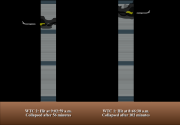In April 1970, the New York City Department of Air Resources ordered contractors building the World Trade Center to stop the spraying of asbestos as an insulating material.[13]
Fireproofing was incorporated in the original construction and more was added after a fire in 1975 that spread to six floors before being extinguished. After the 1993 bombing, inspections found fireproofing to be deficient. The Port Authority was in the process of replacing it, but replacement had been completed on only 18 floors in 1 WTC, including all the floors affected by the aircraft impact and fires,[14] and on 13 floors in 2 WTC, although only three of these floors (77, 78, and 85) were directly affected by the aircraft impact.[15][note 2] and that the fireproofing was being replaced due to its asbestos content, in fact the builders had been informed of a proposed ban on using asbestos/vermiculite fireproofing during construction and had ceased using it. By this time, only the fireproofing of the lower 40 floors of the north tower had been completed, and more than half of this was later replaced before the building was completed.[16] Although replacement fireproofing was specified at 1.5 inches (3.8 cm) in thickness, NIST found the average thickness to be 2.5 inches (6.4 cm).[17] NIST concluded that "the existing condition of the fireproofing prior to aircraft impact and the fireproofing thickness on the WTC floor system did not play a significant role".
